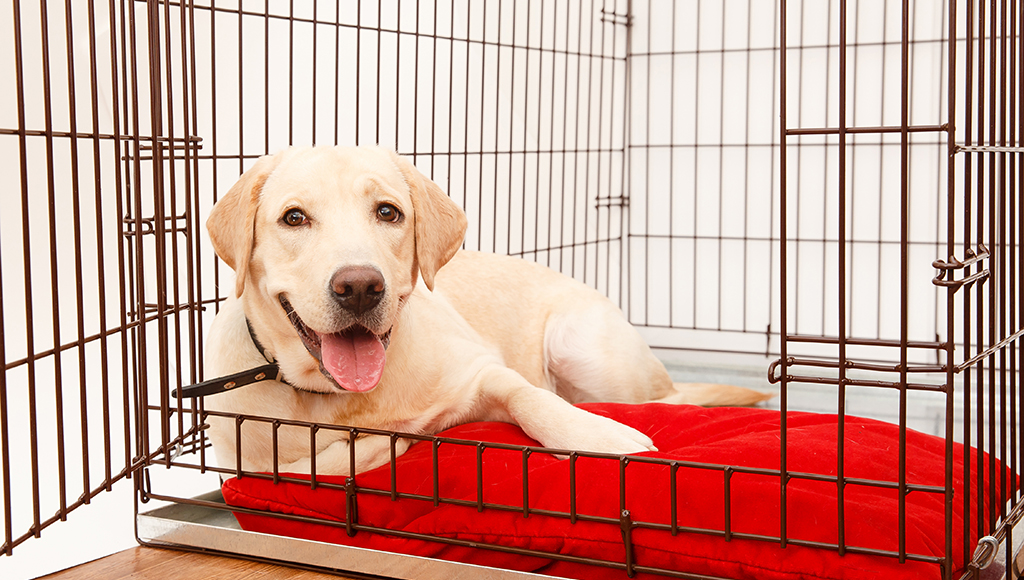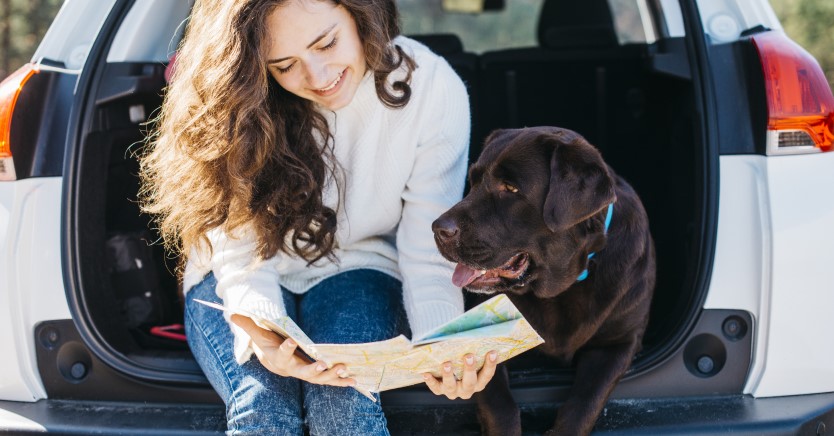Crate Training Part 2: The Adult Dog
Tips for graduating your dog to house freedom while you are away.

Graduating Your Dog to House Freedom
You’ve used a crate to manage your puppy and now you’re wondering how to start giving him more freedom. Well, if you’ve done your foundation work well and haven’t let your dog pick up bad habits, transitioning to full freedom in the house should go fairly smoothly.
- Ideally, your dog should be past the puppy and juvenile stage. For small dogs, this probably occurs at 1-1/2 to 2 years of age. For larger dogs, they may still be an “adolescent” up until 2 to 2-1/2 years of age. In addition, you should have managed your puppy carefully so he knows what items are his to play with, which furniture he is allowed on (or not), and which areas and objects are totally off limits.
- Set your dog up to succeed! Pick up everything on the floors (like shoes), remove everything from the counter tops (we don’t want to tempt him), make sure your trash is secured, and shut all the doors to the extra rooms (don’t forget bathrooms where toilet paper rolls can be tempting!)
- Make sure your dog is exercised before you leave the home. Take him outdoors before you leave and watch to make sure he relieves himself before take him back indoors. You should also take him for a walk or play a game of fetch so you don’t leave him with any pent up energy.
- Leave your dog his favorite toys to play with. A food-stuffed Kong is always a great choice. Many people pack their Kong with something extra special that the dog only gets when they leave.
- The first few times you’re gone should be very short; literally for only a few minutes. Just run down the street to the convenience store or out for ice cream. You don’t want to leave him alone long enough to get bored.
- As your dog gets used to you being gone for short periods of time, gradually begin extending the amount of time you are away. Remember, you can always use the crate for part of the day and leave him loose the rest of the time.
- Use baby gates and closed doors to limit his freedom throughout the house. As you observe him able to handle the freedom, you can gradually allow him access to more of the house. Do this gradually, as too much freedom all at once may be too much of a temptation causing your canine friend to go overboard in his play.
- By gradually allowing more freedom and setting your dog up to succeed, you should be able to allow your dog to have run of the house in a matter of a month or two. If you experience a setback, take a hard look at the circumstances to determine who was at fault. Did you leave your dog unexercised, bored, or with too many temptations? If so, rectify that and try again.
- Don’t let your dog make a mistake more than two or three times, because it will quickly become a habit. You may need to go back to using the crate and work on training your dog’s house manners. Always remember: you cannot punish bad behavior after the fact!! If your dog gets in trouble while you are gone, scolding him when you get home won’t help because he’ll have no idea what he is being scolded for. Just try to set things up so your dog cannot get in trouble next time.
Good Things About Crates
Crates are often considered a punishment tool, or are associated negatively with training a puppy, or dog. There are many good reasons to crate train a dog:
- Crates are den-like and can provide the dog a place of security and comfort. This can be very helpful when visitors come to your home that your dog is not familiar or comfortable with. He will feel safe in his crate.
- Crates serve as the dog's own personal space (like a teenager's own room, away from the family).
- When traveling, crates provide safety for you and your dog. Also, some hotels require that dogs be crated.
- Anxious dogs with borderline separation anxiety or thunderstorm phobia may elect to go into their crate as a safe haven, especially when their owner is not around (Note: the door should be left open if you are not home, so the dog can enter if he needs to).
- Crate training should begin the moment you bring the young pup home. As you walk in the door, pup in arms, the crate should be there, properly equipped, as a retreat for the youngster from that day forward. If the pup's acclimation to his new crate is performed thoughtfully and patiently, there is no reason that your pup's crate should not become its friend for life. However, if mistakes are made at this critical time, or started well after the puppy has arrived, later the grown up dog, can come to loath and detest this small space that should have become his home.
Mistakes That Make a Crate an Unhappy Place
- Forcing a puppy to go inside a crate when he doesn't want to.
- Having a crate that is too small for a large pup so that he is physically restricted and uncomfortable.
- Having a bleak interior to the crate (no blankets, no toys, and no treats).
- Leaving the pup in the crate for too long a period or too much over a 24-hour cycle (so that he feels like a prisoner rather than a family member).
- Using the crate as a place of punishment ("time out" in the crate). DO NOT DO THIS, or the dog will never go into the crate willingly, no matter how old he is.
The Result of Crate Aversion
If a crate has been rendered aversive to a puppy by any one of the means listed above, he will not want to go inside and will complain when confined. He may become stressed and anxious and injure himself in frantic attempts to escape. In addition, a puppy that is confined in a crate too long may be forced to urinate or defecate inside it. Once the sanctity of the crate is defiled in this way, it may no longer be a useful tool for house training. Puppies can't tell you if you are doing something to them that they do not like or that causes them discomfort, so they will act out their grief. The behaviors present in dogs who do not like being crated are:
- Puppies acting aggressively, nipping or biting as you try and shove them into the crate.
- Protest barking after you have shut the door, or they may scratch frantically in futile attempts to escape.
- Biting the door of the cage in angst and sometimes cutting or injuring themselves.
- More passive dogs, rather than acting out in the ways listed above, internalize and displace their stress by either a) licking either the inside of the crate or themselves, b) turning in small circles within the crate (if space allows) or c) defecating and eating their own feces
- All these problems appear to be diverse but, in fact, are all caused by the fact that the puppy was not properly acclimated to its crate or that the crate was abused by the pup's owner, rendering it aversive to the animal
The Solution
As usual, prevention is better than cure, but the way forward is similar in both instances:
- Make the crate a comfortable and cozy place with padded bedding for the dog to lie on. Use bumpers around the side of the crate for the pup to lean on, and place a cover over the top if the crate is made of wire to add that den-like dimension.
- Make sure the crate is large enough for the dog to be able to stand up and wide enough for him to be able to turn around.
- Feed the puppy progressively closer to the open door of the crate, eventually putting the food bowl just inside the crate so that he has to put his head and shoulders inside to eat.
- Hide food treats under the padding of the crate and enrich the interior with favorite chew toys.
- Once the puppy has overcome its immediate fear of being near the crate, you can try confining him for short periods of time, say, 5 minutes, immediately after he has finished a burst of highly energetic play and is due to rest. Stay with him and talk to him so he knows he is not alone.
- Slowly increase the time for which the puppy can be enclosed in the crate from 5 to 15 minutes but stay with him and/or have the crate in the same room (15 minutes is a useful period of time to confine the puppy for house training following an unsuccessful outside "bathroom run").
- At all other times the crate door should be open and the crate should be enriched in the way described so the pup is free to come and go as he pleases.
Other Problems
Puppies that are properly acclimated to their crate may still have crate-related problems that are not due to crate aversion. The first of these is non stress-related urination or defecation within the crate.
An overly large crate may be a contributing factor here. If an owner confines a tiny breed puppy in a massive, large dog crate, the puppy may adopt one end of the crate for sleeping and the other for elimination (i.e. it can get away from its mess). Elimination within the crate arises because of relative oversize of the crate. While it is important that crates are not too small, they should also not be too big either. Simply fulfilling the minimum requirements for height, width, and length is the way to go, so that the puppy is obliged to hold its urine and feces for fear of soiling the area in which it stands. Keeping the sleeping bed clean is a natural behavior for puppies. However, if thoughtless humans confine the puppy for too long this natural tendency will be overcome. The latter situation is not a puppy problem or crate problem, it is an owner problem.
Another problem that can develop in time is over-protectiveness of the crate. If an owner has done too good a job at acclimating their puppy to a crate but has not done a particularly good job at setting limits and conveying their leadership, some puppies may become aggressive (barking, bearing teeth, and so on) when their owner approaches the crate or tries to take them out of the crate. A leadership program conducted by the owners will help to alleviate this situation and it may be necessary to move the position of the crate, or even to deny the dog access to it for a while, until the owner's authority is increased.
Conclusion
It is well worthwhile spending a little time acclimating a puppy to its crate after its arrival in its new home. Problems related to crate training should be identified early, carefully thought out, and be worked out and/or addressed immediately but with patience. Forcing the issue is never an option as it will tend to make matters worse. Instead, patience and understanding of the puppy's concerns are of paramount importance. Perseverance wins every time. Consider this: There are four things that a new puppy owner should ensure for their dog-to-be to stand it in good stead for the rest of its life. The first is proper veterinary care, the second is some element of training and limit setting, the third is neutering of dogs not intended for breeding, and the fourth is to provide constant access to a crate. "A crate for life" should be the dog owner's maxim.
If properly introduced and properly employed, your dog's crate can become its favorite resting place and retreat. Many owners erroneously assume that a crate is just something you have around during a puppy's first few weeks at home to assist with housebreaking. But crates are far more versatile and valuable than this and should really become a lifelong feature. Dogs are den dwellers by nature and if you give away their crate once they're house-trained they will find other small spaces in which to sequester themselves when they feel like getting away from it all. Why deprive them of their original den and enforce them to hide under furniture instead?
Ready to start saving money on pet wellness care?
Then take a look at Mint Wellness, the pet wellness plan that provides fast reimbursement on routine pet care. Save on vaccinations, wellness exams, preventatives, dental, and more!
Learn More


